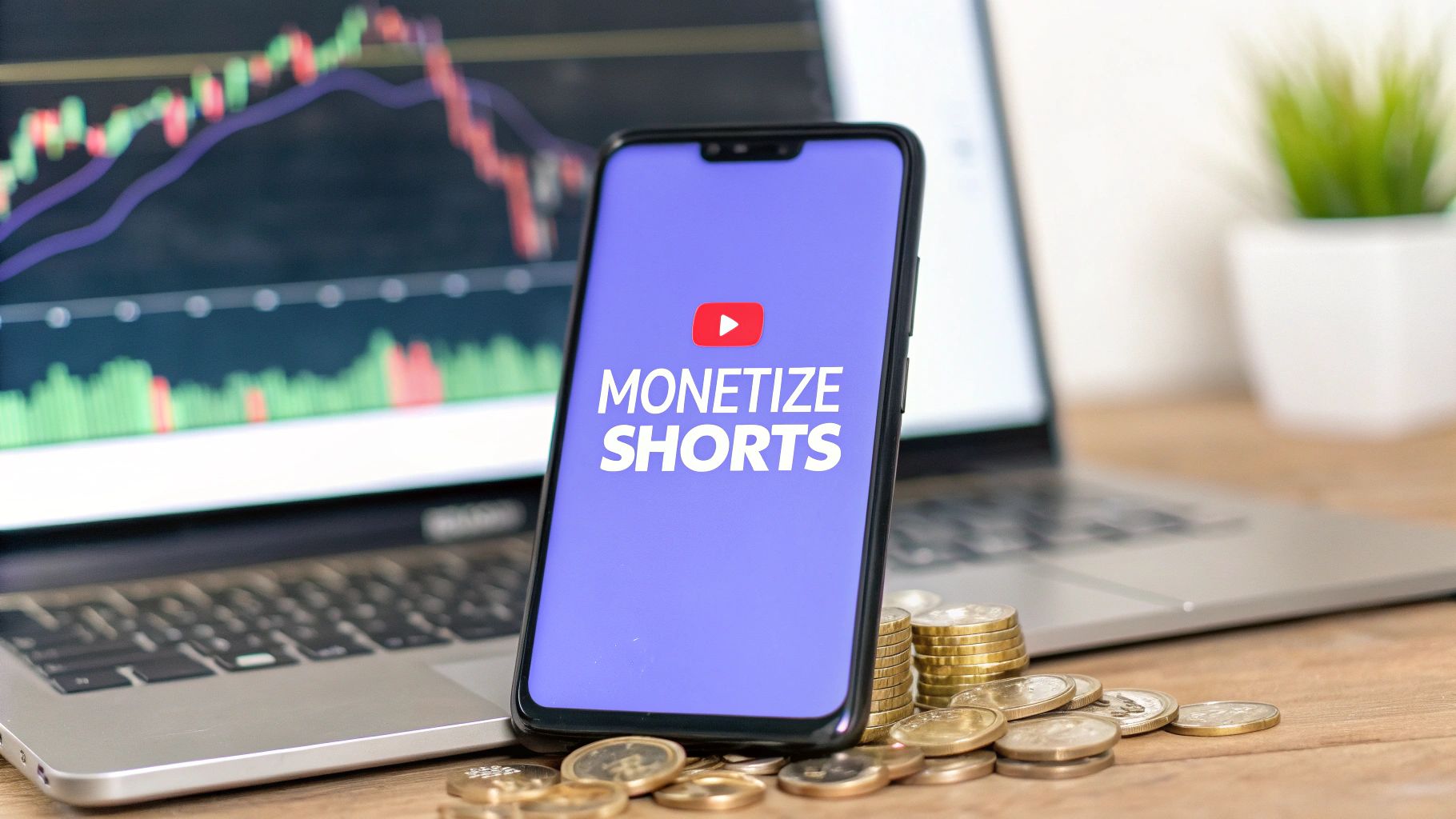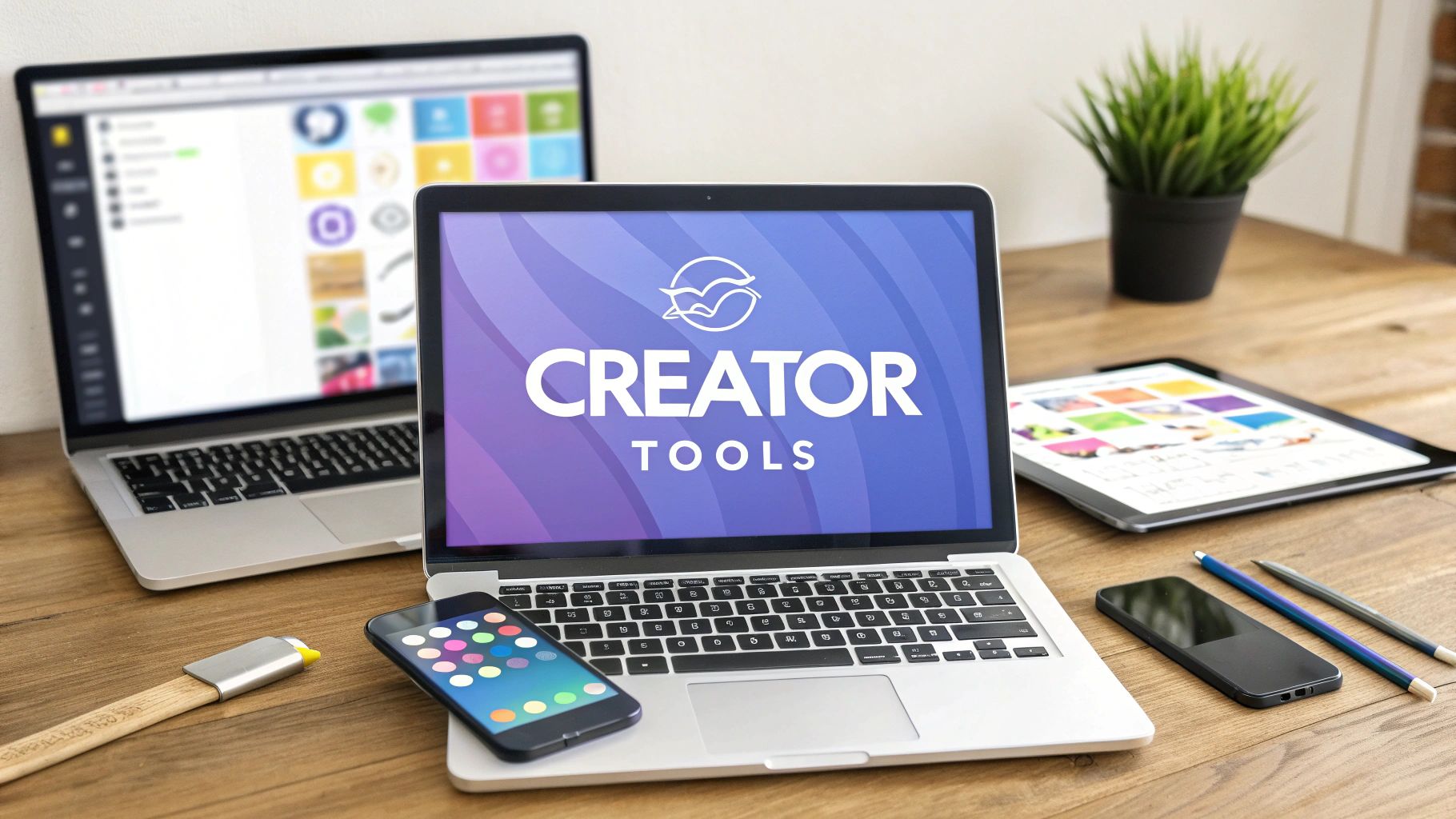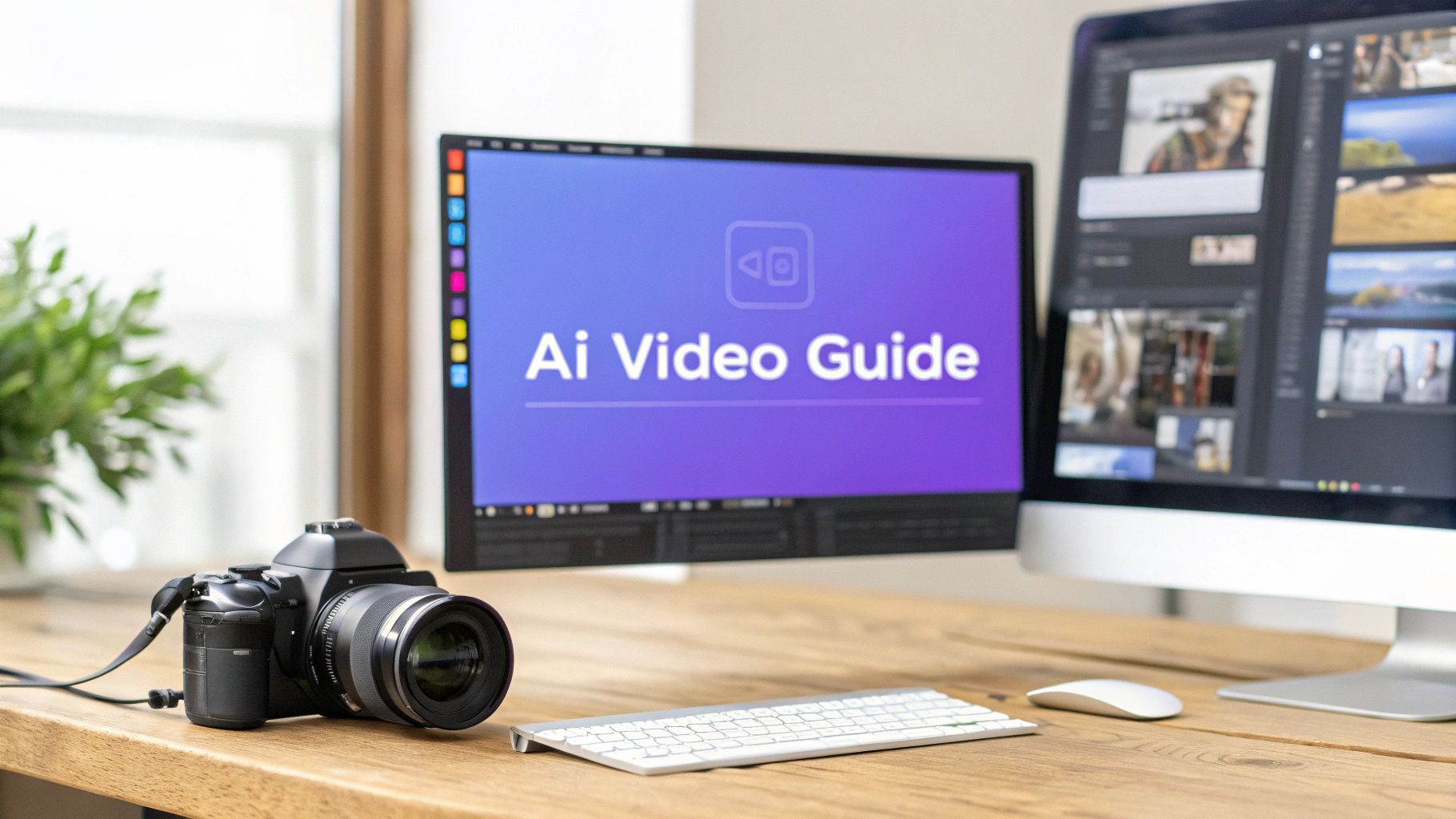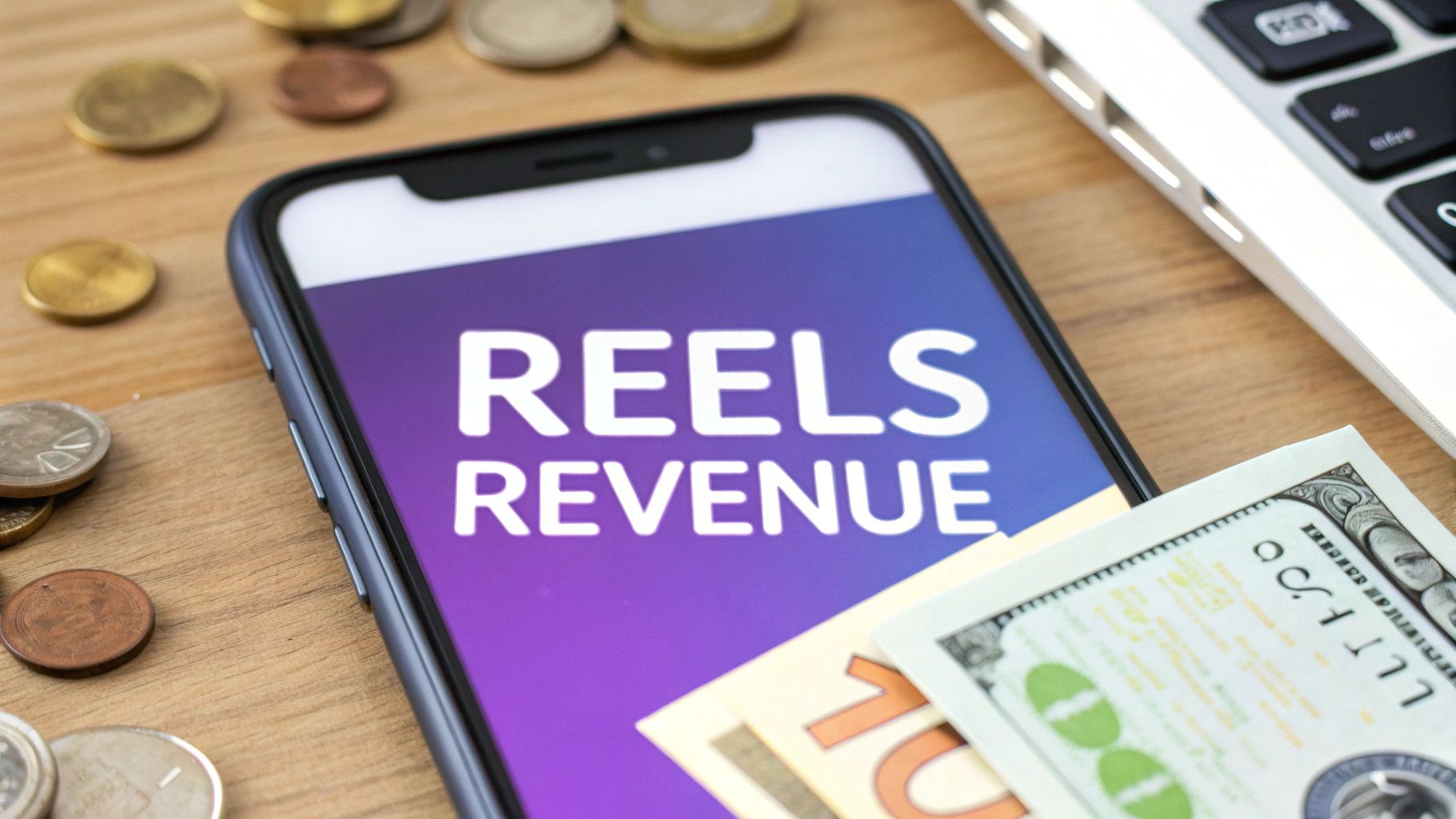Making money from YouTube Shorts all comes down to the YouTube Partner Program (YPP). This is where you get a piece of the ad revenue that plays between videos in the Shorts Feed. It's a much more stable way to earn than the old bonus funds YouTube used to hand out. But first, you have to get in the door by meeting their eligibility rules.
Let’s break down exactly how this works.
Unpacking The YouTube Shorts Monetization Model
Before we get into the nitty-gritty of making money, it’s important to understand what YouTube Shorts are and where they fit in the grand scheme of YouTube. They're not just a sideshow; they're a massive part of how creators are now building an audience and earning a real income from short, punchy videos.
The system we have today is a huge improvement. Originally, YouTube was just giving out bonuses from a temporary fund, which was unpredictable. Now, Shorts are a core part of a real, sustainable revenue-sharing program.
The Shift From Funds To Ad Revenue
YouTube's monetization strategy for Shorts has come a long way. The big change happened in February 2023 when Shorts were officially brought into the YouTube Partner Program. Before that, creators were paid from a $100 million YouTube Shorts Fund, which was basically a pool of money YouTube used to send one-time bonus payments to top creators.
Now, it’s a true ad-revenue sharing model. Creators get 45% of the ad money generated from their Shorts, with YouTube keeping 55%. That split might seem backward compared to long-form videos, but it helps YouTube cover the massive music licensing fees that are so essential for making Shorts go viral.
This switch from a bonus fund to a dynamic ad-share system was a game-changer. It created a more consistent and scalable income stream that actually grows with your channel.
The move to a revenue-sharing model was YouTube's way of saying that Shorts are a permanent, core part of the platform. It gives creators a real stake in the ecosystem's success, rather than just competing for a slice of a temporary bonus pie.
Why This Model Is A Win For Creators
The current system is just plain better than the old Shorts Fund, especially for creators who are serious about building a career on the platform. The benefits are pretty clear:
- Predictable Income: Your earnings are tied directly to your views. While the exact amount you make per thousand views (RPM) can vary, your income grows as your audience does. This makes it much easier to forecast your earnings.
- Long-Term Sustainability: The YPP isn't going anywhere. Unlike the Shorts Fund, which was always meant to be temporary, this revenue stream is here to stay.
- Direct Correlation to Performance: You earn based on how well your content does. The more valid views you get, the bigger your slice of the ad revenue pie. It’s a direct incentive to make great, engaging videos.
- Access to More Tools: Once you're in the YPP through Shorts, you also unlock other cool monetization features like Super Thanks, which lets your viewers tip you right on your Shorts.
To really see the difference, it helps to compare the old and new models side-by-side.
Comparing Shorts Monetization Models
Here’s a quick look at how the previous YouTube Shorts Fund stacks up against the current YouTube Partner Program (YPP) ad-revenue sharing model.
| Feature | YouTube Shorts Fund (Old Model) | YPP Ad-Revenue Sharing (Current Model) |
|---|---|---|
| Payment Structure | One-time bonus payments | Ongoing, monthly revenue share |
| Earning Potential | Capped by the $100M fund size | Unlimited; scales with platform growth |
| Predictability | Low; creators were notified after the fact | High; earnings tied directly to view counts |
| Eligibility | Invitation-only based on performance | Clear public requirements (subscribers/views) |
This new approach really solidifies short-form video as a viable career path on YouTube, not just a way to grow your channel. It ensures that as the Shorts platform gets bigger and brings in more advertisers, you'll get a direct cut of that success.
Joining the YouTube Partner Program for Shorts
Getting into the YouTube Partner Program (YPP) is the single most important step to making real, consistent money from your Shorts. It's the official system that lets you earn a cut of the ad revenue that plays between videos in the Shorts feed.
But you can't just flip a switch. YouTube needs to see that you've built a real audience first. Think of the YPP requirements as a gatekeeper—they're in place to make sure you can consistently pull in viewers before you start getting paid.
Understanding the YPP Entry Requirements
To get into the YPP and unlock ad revenue, you have to hit a couple of key milestones. YouTube gives you two paths to get there, but one is specifically designed for Shorts creators.
Here's the main goal for Shorts-focused channels:
- Get 1,000 subscribers.
- Rack up 10 million valid public Shorts views in the last 90 days.
If you also make traditional long-form videos, you have another option: 1,000 subscribers plus 4,000 valid public watch hours on those longer videos over the past 12 months. But if you're all-in on Shorts, that 10 million view count is your magic number.
What does YouTube mean by "valid" views? It's simple: they only count views from real people watching your public Shorts. Views on private videos, anything you’ve deleted, or views you paid for through an ad campaign won't count. They're looking for genuine, organic reach.
How to Actually Get 10 Million Views
Hitting 10 million views in just 90 days can feel like a huge mountain to climb, but it's totally possible if you're smart about it. The secret isn't one viral video; it's a steady stream of engaging Shorts that keeps people watching.
Here are a few things that work for me:
- Nail the First 2 Seconds: This is everything. You have a tiny window to stop someone from swiping. Start with a shocking statement, a fast-paced action, or a question that makes them need to know the answer. If you don't hook them instantly, they're gone.
- Jump on Trends: Keep an eye on trending sounds, challenges, and editing styles. Using a popular audio track can get your Short served to millions of people who are already watching content with that sound. It's like a free discovery boost.
- Make Your Content Loop: Try to end your Short in a way that flows seamlessly back to the beginning. A perfect loop tricks the viewer's brain into watching a second or third time before they even realize it, which juices your view count and watch time.
A channel with ten Shorts that each get one million views is often in a much better position than a channel with one viral hit that got 10 million. Consistency proves you have a formula that works, not just a one-off stroke of luck.
This infographic does a great job of showing how the different monetization paths work.
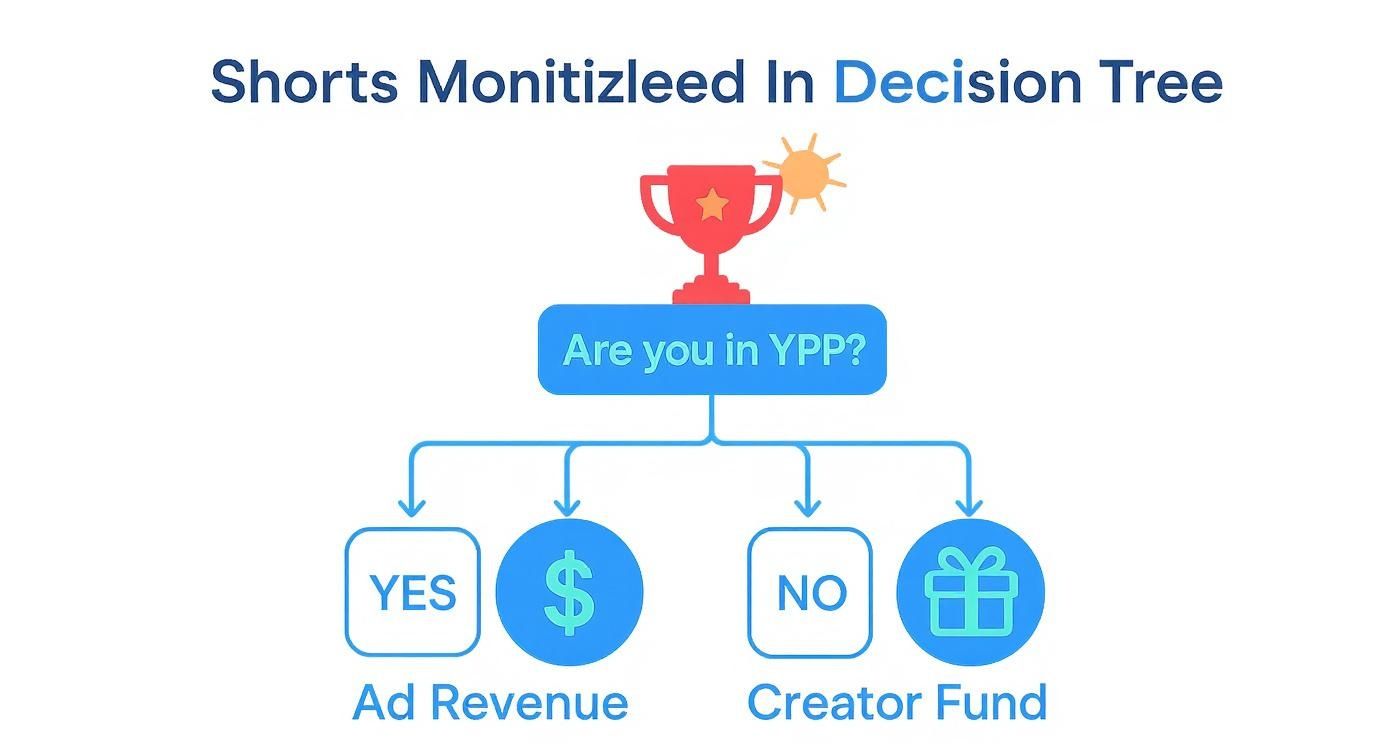
As you can see, being in the YPP is what opens the door to ad money, which is typically the most reliable income stream.
The YPP Application Process Explained
Once you've finally hit those numbers, it's time to apply. You can do it right from your YouTube Studio dashboard. The application itself is easy, but your channel is about to be put under a microscope.
Here’s a quick rundown of what happens next:
- Hit "Apply": In YouTube Studio, go to the "Earn" tab. Once you're eligible, a big blue "Apply" button will be waiting for you.
- The Human Review: This is the most important part. A real person at YouTube will go through your channel to make sure you're following the rules—the Community Guidelines, Terms of Service, and AdSense policies.
- The Decision: This usually takes about a month. You'll get an email letting you know if you're in or not.
So, what are the reviewers looking for? Originality. They want to see that you're creating something new, not just re-uploading movie clips or TV shows without any commentary or changes. Lazy, repetitive content is a major red flag. Everything you post should have your unique spin on it.
If you happen to get rejected, don't panic. YouTube will tell you why. You can fix the issues they point out and re-apply in 30 days.
So, you’ve made it into the YouTube Partner Program. Congratulations! But now the real work begins. Your goal shifts from just chasing views to attracting high-value views—the kind that actually pad your AdSense account.
To do that, you need to understand how YouTube slices up the Shorts ad revenue pie. It’s not one ad per video. Instead, YouTube pools all the ad money earned from the Shorts Feed and then divides it among creators. Your cut depends on your share of total views and whether you used licensed music. Your mission is to claim the biggest piece of that pie you possibly can.
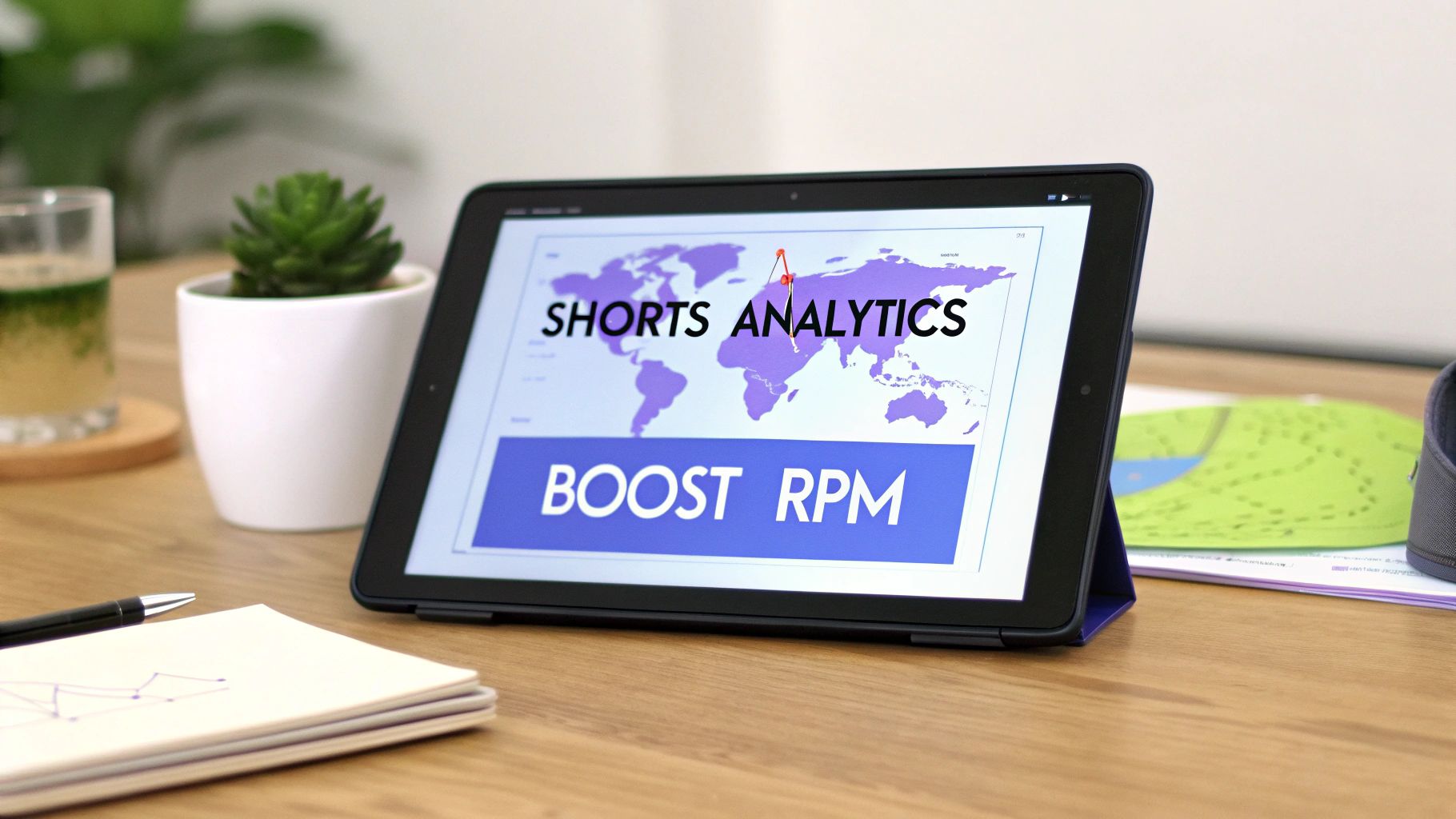
Cracking the RPM Code
The metric that matters most here is your RPM, or Revenue Per Mille. It’s the amount of money you earn for every 1,000 views. And let me tell you, not all views are created equal. Some are worth ten times more than others.
What's the biggest factor? Your audience's location.
Advertisers pay a premium to reach viewers in countries with high consumer spending power. A view from someone in the United States, the UK, or Canada is simply worth more than a view from a region where ad budgets are smaller. While you should never alienate your core fans, making content that also clicks with these "Tier 1" audiences can seriously boost your income.
How to Target High-RPM Audiences Without Selling Out
Pivoting to attract a higher-paying audience doesn't mean you have to abandon your niche. It's about finding smart, authentic ways to bridge the gap.
Think about it this way:
- Go for Universal Appeal: Some topics just work everywhere. Comedy, cute pets, mind-blowing transformations, or those oddly satisfying DIY projects—they don't need translation.
- Sprinkle in Cultural Cues: You can make your content more relatable to Western audiences by incorporating things they already know and love. Think globally recognized meme formats or talking about a blockbuster movie.
- Use English and Captions: This is the most direct route. Creating content in English instantly opens the door to high-RPM countries. And always, always use clear captions. It makes your videos accessible to literally everyone.
For example, I saw a food creator from India make a Short about a local street food. Instead of just showing it, they framed it as a "crazy delicious snack you have to try." That small change in language made it instantly intriguing to a global audience without losing its authenticity.
The goal isn't to replace your audience; it's to expand it. You're building a bridge, inviting new people into your world by speaking a language and using themes they already get.
Why Geography Is a Game-Changer
The difference in RPM from one country to another can be absolutely massive. This isn't random; it directly reflects the local ad markets.
Data on Shorts monetization shows just how wide the gap is. In a high-income country like the United States, a creator might see an RPM around $0.33. In Switzerland, it’s about $0.21, and in Australia, it’s closer to $0.19. But in massive markets like India and Indonesia, the RPM can drop to around $0.008 and $0.012. They often make up for it in sheer volume of views, but the per-view value is a fraction of the top-tier countries. Check out a deeper dive on what RPM to expect from Shorts on air.io for more context.
This is exactly why a strategic approach to your audience is non-negotiable if you're serious about monetizing Shorts.
Looking Beyond Location
While geography is a huge piece of the puzzle, don't forget the other factors that influence your earnings. You need to be your own channel's biggest critic, constantly digging into your analytics to see what's hitting and what's missing.
When you understand how people are really interacting with your videos, you can make smarter decisions that lead to more engagement and, ultimately, more money. You can get a great primer by reading our guide on understanding your video marketing analytics.
Here are the metrics I live by for Shorts:
- Viewed vs. Swiped Away: This is the big one. What percentage of people stick around versus immediately swiping away? If your swipe-away rate is high, your hook is broken. Fix it.
- Average View Duration: Even for a 30-second video, you want people watching for as long as possible. A longer duration tells YouTube your content is sticky and worth pushing to more people.
- Audience Demographics: Keep an eye on where your views are coming from. If you spot a small but dedicated pocket of viewers from a high-RPM country, that’s your signal to create more content that speaks directly to them.
Monetizing Shorts Beyond Ad Revenue
Thinking that Shorts ad revenue is the only way to make money is a huge mistake. The smartest creators I know treat ad-share as a nice bonus, not the main event. Your Shorts are magnets for building a community, and that attention is something you can guide toward far more profitable ventures.
You have to start thinking like an entrepreneur, not just a creator. Your Shorts feed is essentially the top of your marketing funnel. It’s how you attract millions of eyeballs and introduce them to your brand, your affiliate partners, or your own products. This mental shift is what turns a fun channel into a real, diversified business.
Let's break down some of the most powerful income streams you can build off the back of your Shorts.
Securing Brand Partnerships and Sponsorships
Brand deals are, without a doubt, one of the most lucrative paths for Shorts creators. Brands are desperate to connect with engaged audiences in a way that feels real, and your Shorts are the perfect vehicle for that. In fact, marketers are pouring money into short-form video because it pulls in 2.5 times more engagement than traditional long-form content.
And you don’t need a million subscribers to get started. Brands are increasingly looking for micro-influencers with smaller, dedicated followings in a specific niche. It’s all about proving you have a genuine connection with an audience they want to reach.
First things first: you need a professional media kit. Think of it as your channel's resume. It needs to include:
- Audience Demographics: Who watches you? Break down their age, gender, and where they live.
- Key Performance Metrics: Show off your average views per Short, your engagement rate (likes and comments are gold), and your subscriber growth trends.
- Your Niche and Value: Spell out what your channel is about and why your audience trusts your recommendations.
When you're ready to start pitching, go after brands that genuinely make sense for your content. If you review gadgets, pitching a makeup company is a waste of everyone's time. The best partnerships feel like authentic recommendations, not clunky ads. That leads to better results for the brand and, more importantly, keeps the trust you've built with your viewers.
A killer pitch isn't about what a brand can do for you; it's about what you can do for them. Frame your proposal around how your audience is their ideal customer and how your creative ideas will help them hit their goals.
Mastering Affiliate Marketing in Shorts
Affiliate marketing is another fantastic way to earn money without a massive audience. The idea is simple: you talk about a product or service, share a unique link, and get a commission for every sale that comes through it. It's a low-risk strategy that fits perfectly with the quick, punchy format of Shorts.
The trick is to make it feel completely natural. Weave product mentions into your content where they belong. For instance, if you run a cooking channel and use a specific air fryer in a recipe, you can casually mention it and drop your affiliate link in a pinned comment.
Here’s how to get it right:
- Find Relevant Programs: Get started with big networks like Amazon Associates, ClickBank, or ShareASale. You can also check the websites of brands you already use and love—many have their own direct programs.
- Integrate Links Smartly: Your pinned comment and video description are your best friends here. Use a link shortener like Bitly to create clean, trackable links.
- Be Transparent: Always let your audience know you're using affiliate links. A simple
(#ad)or(#affiliatelink)is all it takes to build trust and stay on the right side of platform rules.
By promoting things you actually believe in, you're not just selling; you're providing value. This approach strengthens your relationship with your audience while building a steady, passive income stream.
Driving Viewers to Your Own Products
For many creators, the ultimate goal is selling their own stuff. Whether it's digital products, merchandise, or services, this gives you total control over your income and lets you build a brand that lives beyond YouTube. Your Shorts become a free, viral ad engine driving traffic straight to your digital storefront.
This strategy works in just about any niche you can imagine. A fitness creator might sell workout plans. An artist could sell digital prints or merch with their designs. A business coach can promote paid webinars or an ebook.
To make it work, your Shorts need a clear call-to-action (CTA). It doesn't have to be a pushy sales pitch. Something as simple as, "If you want to dive deeper, grab my guide at the link in my bio!" works wonders. You can also use on-screen text or a pinned comment to point people to your online store or email list. Some creators have even found success repurposing their content for user-generated content ads, which is a brilliant way to promote your products on other social media platforms.
By creating a clear path from your viral Shorts to your own products, you turn casual viewers into paying customers and build a sustainable business that you truly own.
Income Streams for Shorts Creators
To help you visualize the possibilities, here’s a quick breakdown of how these different monetization methods stack up against each other.
| Monetization Method | Earning Potential | Effort Level | Best For |
|---|---|---|---|
| YouTube Partner Program | Low to Medium | Low | All eligible creators as a base income. |
| Brand Partnerships | High | Medium to High | Creators with an engaged, niche audience. |
| Affiliate Marketing | Medium | Low to Medium | Creators who genuinely use and love specific products. |
| Selling Own Products | Very High | High | Entrepreneurial creators who want to build a long-term brand. |
Ultimately, the most successful creators don't rely on a single source of income. They build a diversified portfolio where each stream supports the others, creating a much more stable and scalable business.
How to Create YouTube Shorts That Actually Get Views
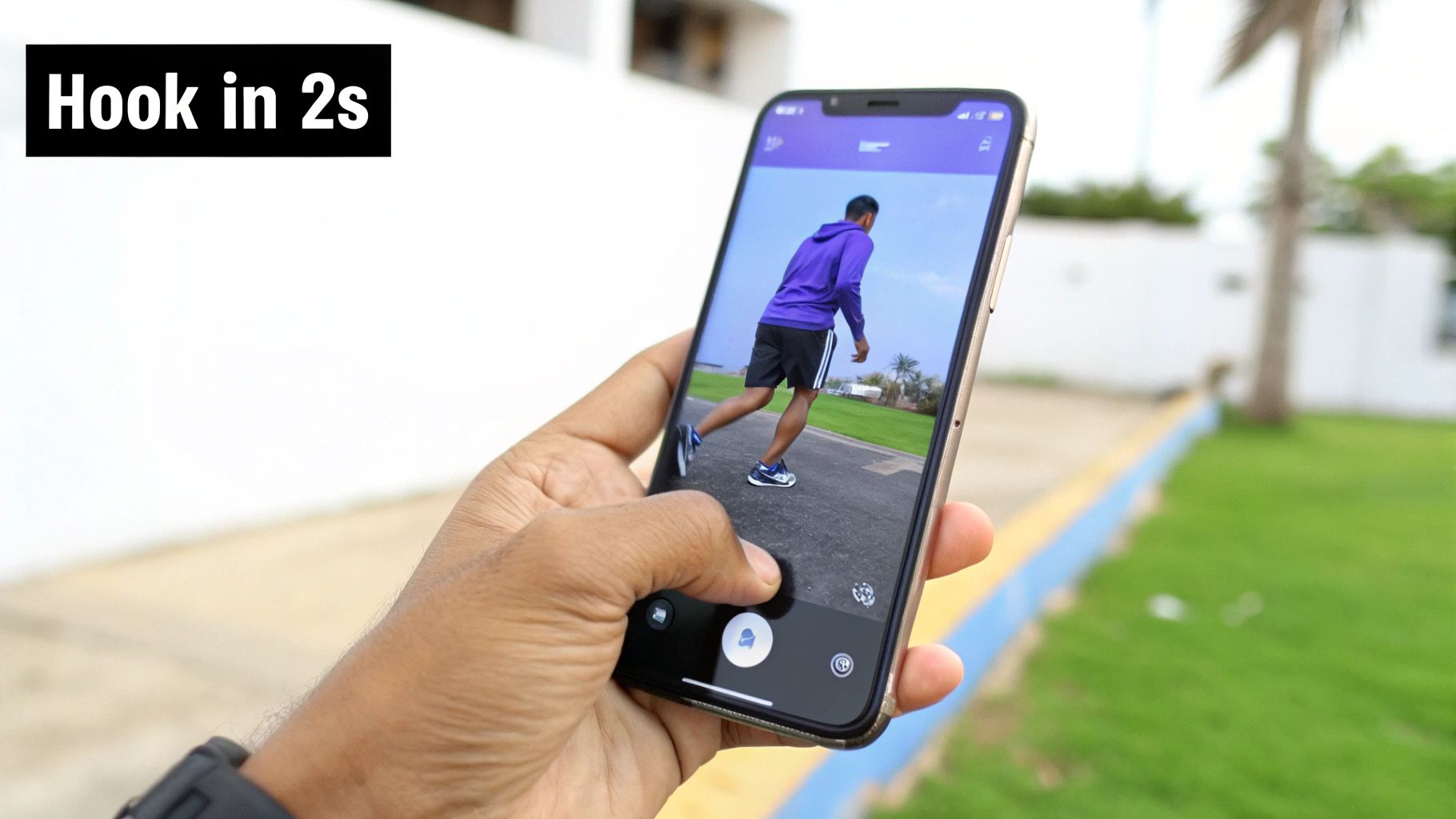
If you really want to monetize YouTube Shorts, you need a steady stream of viewers. It's not just about ad revenue—more views build an audience you can later connect with for brand deals, affiliate links, and your own products. It all comes back to making content that both people and the algorithm can't ignore.
Don't overthink the Shorts algorithm. It's not some secret code to crack. YouTube's main goal is simple: keep people swiping. So, it rewards content that holds a viewer's attention. Your job is to create Shorts so engaging that people stick around for the whole thing, and maybe even watch it again.
Nail the First Two Seconds (Or You're Done)
You have less than two seconds to convince someone not to flick their thumb and scroll past your video. If your opening is slow or confusing, they’re gone. The first few frames of your Short are the most critical part.
Kick things off with immediate action, a provocative question, or a visually stunning shot. Think of it like your video's headline—it has to be strong enough to make someone stop and give you the next 30 seconds. A killer hook dramatically improves your viewed vs. swiped away metric, which is a massive signal to the algorithm.
For example, if you're making a cooking Short, don't start with a boring shot of your ingredients on a counter. Instead, open with the final, mouth-watering dish and overlay text that says, "I made this in 5 minutes. Here's how." You instantly create curiosity and set an expectation.
Master Your Pacing and Edits
The pace of a Short is everything. Short-form video thrives on quick cuts, constant motion, and a feeling that you're always moving forward. There should never be a dull moment.
A few editing tricks can make a world of difference:
- Use Quick Cuts: Keep your clips incredibly short, often less than a second. This creates an energetic, fast-paced feel that keeps the viewer's brain from wandering off.
- Add On-Screen Text: Captions are great for emphasizing key points or adding extra context. Animated text can also add a bit of visual flair that holds attention.
- Weave in B-Roll: Even in a 30-second video, cutting away to relevant B-roll footage makes your content feel more polished and visually dynamic.
Your goal is to surgically remove any "dead air" where someone might get bored. Every single second needs to serve a purpose. Once you’ve mastered the basics of how to upload YouTube Shorts, refining your editing style is what will truly make you stand out.
Tap into Trending Audio the Smart Way
Trending audio is your secret weapon for getting discovered. When you use a popular sound, you're plugging your video into a much bigger conversation. The algorithm often serves up multiple Shorts using the same audio, which can expose your content to a massive new audience.
But don't just slap a trending song onto a random clip. Find a way to creatively integrate the audio into your content so it feels authentic. The best use of a trend is one that adapts it to your specific niche, adding to the humor, emotion, or story you're trying to tell.
The Shorts feed is a massive, fast-moving river of content. Trending audio acts like a current that can carry your video to shores you'd never reach on your own. It's a powerful tool for getting in front of new audiences who are already primed to enjoy that style of content.
Understand What the Algorithm is Looking For
The Shorts algorithm is constantly learning from how people behave. Every like, comment, share, and re-watch sends a positive signal to YouTube that your content is worth watching. This is precisely why a high watch-through rate is so critical.
If viewers consistently watch your entire Short, it tells the algorithm your content is great at holding attention. In response, it pushes the video to more people. This is why "perfect loops"—where the end of the video seamlessly flows back to the beginning—can be so powerful. They trick people into watching multiple times, juicing your metrics.
The scale here is massive. Over 90 billion Shorts are viewed every single day, and more than 2 billion users watch them each month. With an average engagement rate of 5.91%, Shorts offer a huge opportunity to build a highly engaged audience, especially with videos in that sweet spot of 20-to-40 seconds. For an extra edge, a good content creator transcription guide can show you how to use captions to make your Shorts even more accessible and engaging.
Common Questions About Monetizing Shorts
Jumping into Shorts monetization brings up a ton of questions. It's a different beast than long-form video, with its own set of rules and payment systems. Let's clear up some of the common confusion I see from creators so you can get paid without hitting any frustrating roadblocks.
One of the biggest hurdles is understanding what kind of content actually qualifies. YouTube is pretty black-and-white on this: your content has to be original. That means you can’t just re-upload unedited clips from movies, TV shows, or another creator’s stream and expect to earn from it.
But, there's nuance here. If you add your own creative spin—like a funny commentary, a sharp critique, or an educational breakdown—you're usually in the clear. The name of the game is transformation; you have to add real value.
Do I Need 1000 Subscribers to Earn Anything?
This is probably the most common question I get, and the answer isn't a simple yes or no.
If you’re talking about getting a cut of the ad revenue, then yes, the bar is 1,000 subscribers and 10 million public Shorts views in the last 90 days. That's the main gate to the full YouTube Partner Program (YPP).
However, you can start making money sooner. YouTube now offers an earlier entry point to YPP that unlocks fan funding. For that, you only need 500 subscribers and 3 million Shorts views. Once you hit that, you can enable features like Super Thanks, letting your fans tip you directly on your Shorts. It's a great way to start monetizing while you build momentum toward the bigger ad-share goal.
How Much Money Can I Realistically Make?
Let's talk numbers. The revenue per mille (RPM), or what you earn for every 1,000 views, for Shorts typically lands somewhere between $0.03 and $0.10. I know, that doesn't sound like a lot, especially compared to long-form content. But it's a huge step up from the old Shorts Fund, and these rates are slowly but surely getting better as more advertisers jump on board.
So, a Short that hits a million views could net you anywhere from $30 to $100. The real power of Shorts isn't in one viral hit, but in the cumulative effect. The sheer volume of views you can rack up across many videos can really start to add up.
Think of ad revenue as your foundation, not the whole building. The real money often comes from brand deals, affiliate links, and selling your own products—all of which are supercharged by the massive audience you can build with Shorts.
What Happens If I Use Copyrighted Music?
Using popular music is a huge part of what makes Shorts work, but it definitely impacts your bottom line.
When you add a licensed track from YouTube’s library, the ad revenue from that Short gets split. YouTube first pools all the ad money together, uses it to cover the music licensing fees, and then pays out the rest to creators based on their share of the total views.
If you make a Short with only original audio (your voice, royalty-free sounds), you get to keep the full portion of the revenue allocated to you. It's a classic trade-off: a trending song might give you a better shot at going viral, but it means taking a smaller piece of the pie.
Ready to create high-performing social videos without all the hassle? Sprello helps you produce stunning, conversion-focused content in minutes using AI. Generate scripts, build scenes, and use realistic AI avatars to scale your video marketing efforts. Start creating with Sprello today.
